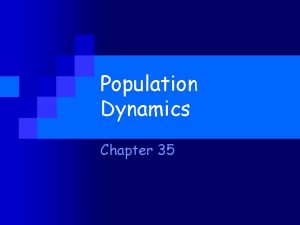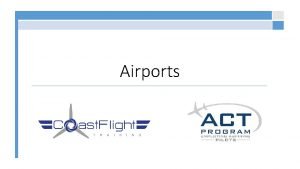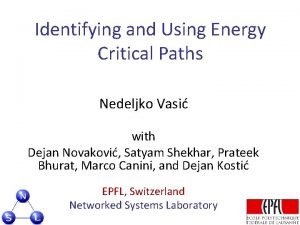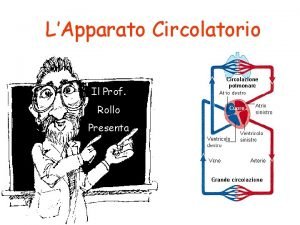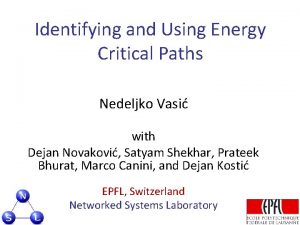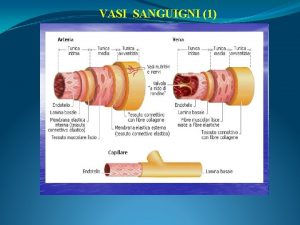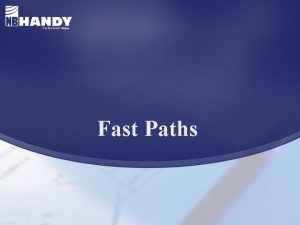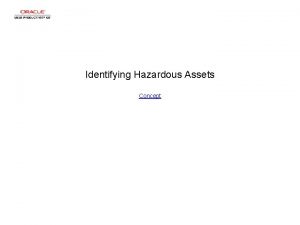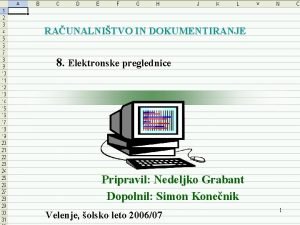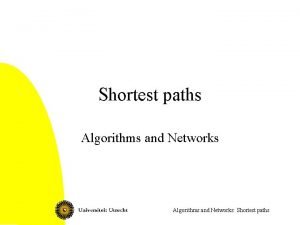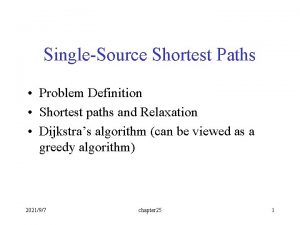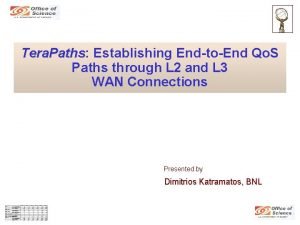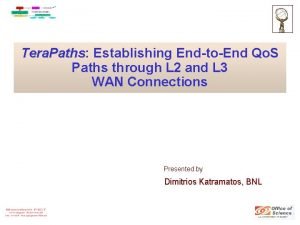Identifying and Using Energy Critical Paths Nedeljko Vasi









![How often is recomputation needed? [Geant 2 - European academic network, 15 -day trace] How often is recomputation needed? [Geant 2 - European academic network, 15 -day trace]](https://slidetodoc.com/presentation_image_h/10730c9ca78daedc3020ca2979c8c2c6/image-10.jpg)

![How often is recomputation needed? [Geant 2 - European academic network, 15 -day trace] How often is recomputation needed? [Geant 2 - European academic network, 15 -day trace]](https://slidetodoc.com/presentation_image_h/10730c9ca78daedc3020ca2979c8c2c6/image-12.jpg)











- Slides: 23

Identifying and Using Energy Critical Paths Nedeljko Vasić with Dejan Novaković, Satyam Shekhar, Prateek Bhurat, Marco Canini, and Dejan Kostić EPFL, Switzerland Networked Systems Laboratory

Networking Energy 20% of total server energy consumption (3 TWh in US in 2006) NETWORK DATACENTER NETWORK Datacenter Several TWh/year for major telcos (Telefonica 4. 5 TWh, Verizon 9. 9 TWh) 2

Causes of networking energy consumption • Network redundancy – Achieving high availability • Bandwidth overprovisioning – Tolerate traffic variations (address lack of Qo. S) 3

Energy-(un)proportionality 100 Power (% of peak) 80 60 Typical utilization levels 40 Existing networking hardware 20 Ideal energy-proportionality 0 0 20 40 60 Utilization (%) 80 100 4

Networking energy outlook • More demands will result in further increases – Video streaming, Cloud computing • CMOS reaching a plateau in power-efficiency – Cooling costs of new equipment will increase Power is not limitless • 1 MW for latest Cisco platform, CRS-1 (60 Amps per rack) Rate of traffic increase > rate in which underlying technologies improve their energy efficiency 5

Goal: Energy-Proportional Networked Systems 100 Power (% of peak) 80 60 40 20 Goal Ideal energy-proportionality 0 0 20 40 60 Utilization (%) 80 100 6

Power (% of peak) Make all devices energy-proportional? Performance penalties Always-on components Ideal energy-proportionality Utilization (%) 7

Network-wide energy-proportionality Sleeping saves energy Dynamically match resources to the demand make the network energy-proportional 8

Routing table computation • Goal: The minimal set of network elements (w. r. t. power) that will satisfy the current demands • Routing that minimizes energy consumption – Multi-commodity flow problem, but with additional constraints for energy objective: Links + routers (switches) powered on/stand by – Problem is computationally intensive – Heuristics take several minutes for small topologies When traffic demand changes, optimal routing changes! 9
![How often is recomputation needed Geant 2 European academic network 15 day trace How often is recomputation needed? [Geant 2 - European academic network, 15 -day trace]](https://slidetodoc.com/presentation_image_h/10730c9ca78daedc3020ca2979c8c2c6/image-10.jpg)
How often is recomputation needed? [Geant 2 - European academic network, 15 -day trace] 10

How often is recomputation needed? 15 min A D . Time B C 11
![How often is recomputation needed Geant 2 European academic network 15 day trace How often is recomputation needed? [Geant 2 - European academic network, 15 -day trace]](https://slidetodoc.com/presentation_image_h/10730c9ca78daedc3020ca2979c8c2c6/image-12.jpg)
How often is recomputation needed? [Geant 2 - European academic network, 15 -day trace] Routing table recomputed 3 -4 times per hour! (state-of-the-art) 12

Issues with recomputation • Long computation time might lead to energy waste or congestion • Adjusting routing upon each change in traffic patterns often leads to oscillations • Network operators would like to base their designs on longer time scales 13

Can we precompute routing configurations? A 15 min D Time B C 14

Can we precompute routing configurations? One routing configuration used 60% of the time Fraction of time an energy-optimal routing configuration is used (Geant 2 trace) Too many routing configurations 15

CDF of Optimal paths included Energy Critical Paths 120 100 80 Geant Fat. Tree 60 40 20 0 1 2 3 4 Number of alternative paths 5 Just a few precomputed paths offer near-optimal energy savings 16

REs. Po. Nse Service-Level Objectives (Responsive Energy-Proportional Networks) Energy-Aware Traffic Engineering Runtime Traffic Measurement [COMSNETS ‘ 09] Online components Offline components Computing Energy-Critical Paths Traffic Analysis 17

REs. Po. Nse Always-on paths provide a routing that can carry low to medium amounts of traffic at the lowest energy consumption On-demand paths start carrying traffic when the load is beyond the capacity offered by the always-on paths Failover paths. REs. Po. Nse are designed to minimize the REs. Po. Nse-lat impact of single failures REs. Po. Nse-heuristic REs. Po. Nse-ospf 18

REs. Po. Nse. TE in action Load(AO) > Tr C D TE Src A B Dest • Online effort to shift traffic to (in)activate on-demand paths • Intermediate routers mark packets with link load • Edge routers collect load info only on alternative paths 19

Evaluation Questions • How energy-proportional is REs. Po. Nse? – ISP topologies – Datacenter networks • How quick is REs. Po. Nse. TE in shifting traffic? • What is the impact of traffic aggregation on application performance? 20

Demands (GBps) Power (% of original) Responsiveness/Energy-Proportionality (Geant) 100 80 60 40 20 5 4 3 • Replayed a 15 -day trace • 2 power models – Today – Future (static power is significantly reduced) REs. Po. Nse saves 30% - 45% with adding only 1 carefully precomputed routing table 2 1 21

Impact on application performance Block retr. latency (s) Live Modelnet experiment with P 2 P-Vo. D (Bullet. Media [IPTV ‘ 07]) Percentage (%) 100 1. 5 95 90 1 0. 5 85 80 0 REs. Po. Nse OSPF low utilization REs. Po. Nse OSPF high utilization REs. Po. Nse OSPF low utilization Application performance and e 2 e latency under REs. Po. Nse is comparable to OSPF at both low and high utilization levels. 22

Conclusion • REs. Po. Nse • Key idea: hybrid offline/online approach based on existence of energy critical paths • Properties • Stable • Incrementally deployable • Responsive REs. Po. Nse enables power/cooling for the common case 23
 Zagreb school of animation
Zagreb school of animation Critical semi critical and non critical instruments
Critical semi critical and non critical instruments Spaulding classification system
Spaulding classification system Adjective
Adjective Whats an adjective clause
Whats an adjective clause Identifying and non identifying adjective clauses
Identifying and non identifying adjective clauses Energy paths
Energy paths What are use cases
What are use cases Papi
Papi Angiosperme
Angiosperme Displaced threshold markings
Displaced threshold markings Vasi comunicanti
Vasi comunicanti Legge di laplace vasi
Legge di laplace vasi Cisco vasi
Cisco vasi La storia dei due vasi cinesi
La storia dei due vasi cinesi Vasi di kamares
Vasi di kamares Luces papi y vasi
Luces papi y vasi Vasi
Vasi Sistema linfatico zanichelli
Sistema linfatico zanichelli Capillari discontinui
Capillari discontinui Cuore vasi
Cuore vasi Vasi sanguiferi
Vasi sanguiferi Ekto paraziti
Ekto paraziti Vasi tayini dilekçesi
Vasi tayini dilekçesi






